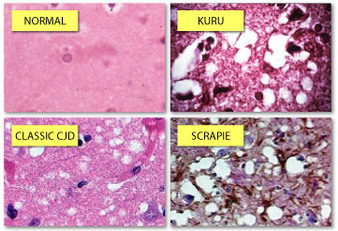Reproduction: (6)
- Prions spread by transmitting a misfolded protein state
- When a prion enters a healthy organism, it causes the existing properly folded proteins to convert to the disease-associated prion form
- To do this, the prion acts as a template to misfold more proteins
- In turn, each newly formed prion goes on to convert more proteins itself
- This triggers a chain reaction that produces large amounts of the prion form

Pathology:
Pic is (15)
Pic is (15)
- Diseases caused by prions are called transmissible spongiform encephalopathies (TSEs) which are always fatal (2)
- Characteristic of infection include: loss of motor control, dementia, paralysis, encephalitis, widespread neuronal loss (2)
- The prion altered protein structure is extremely stable and accumulates in infected tissues, causing tissue damage and cell death (8)
- The stable structure of prions makes them hard to eliminate with chemical and physical agents, making it hard to dispose of or contain them (8)
- The main part of the brain affected by the Kuru prion is the Cerebellum (6)
